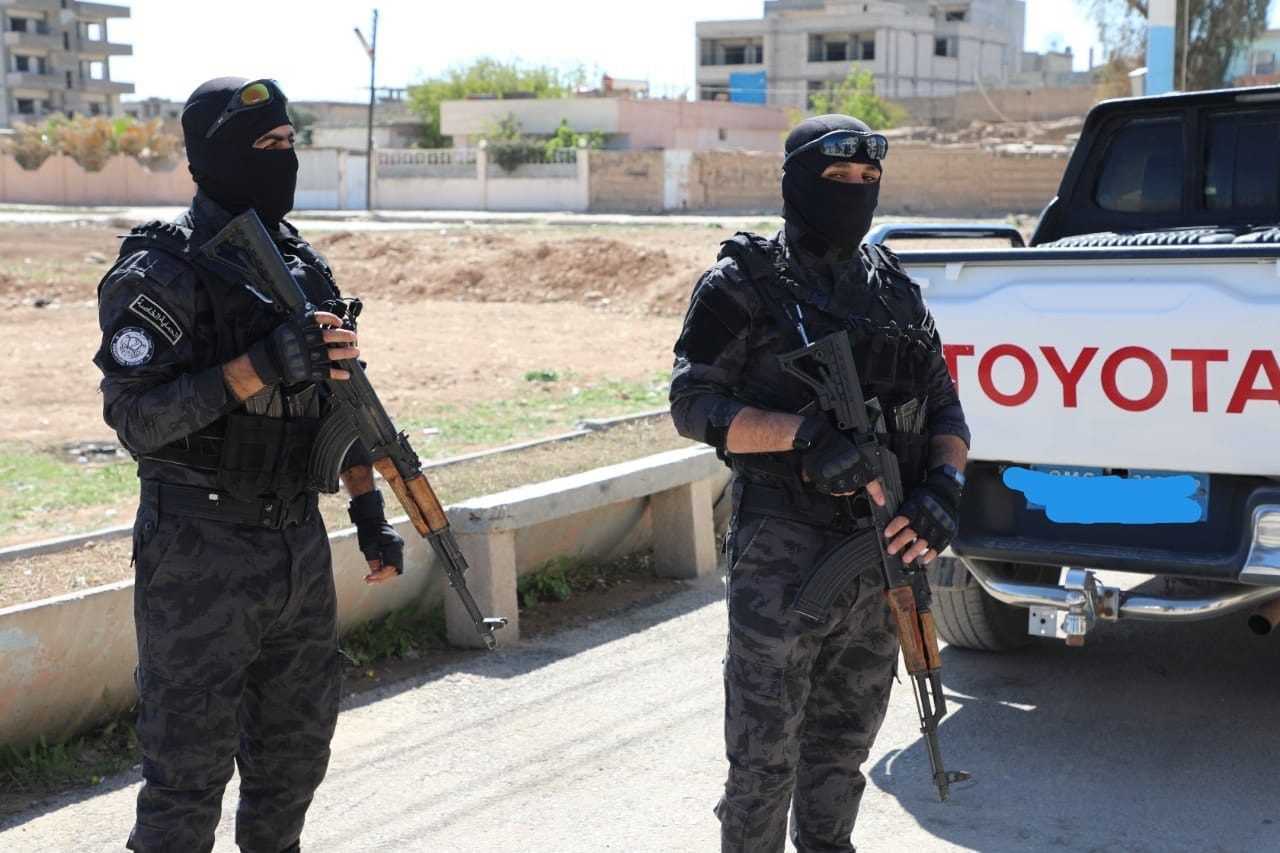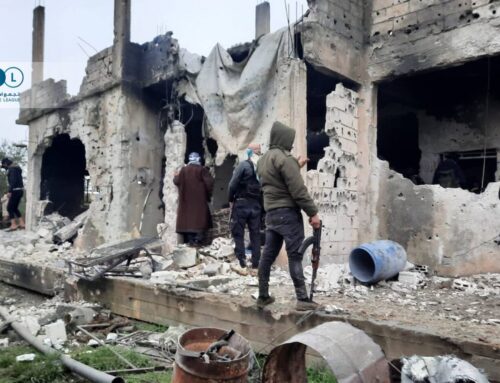When the sun sets, SDF control over northeastern Syria’s highways wanes
On a map, the Syrian Democratic Forces control more than 25 percent of Syria’s territory, but the on-the-ground reality is more complicated. IS cells persist in the northeast and some highways remain too risky even for security forces to travel after sunset.
14 June 2022
PARIS — On maps showing military influences in Syria, a swathe of yellow represents the control of the Syrian Democratic Forces (SDF) over parts of Syria’s north and east—more than 25 percent of the country. But when the sun sets, some of this influence subsides, particularly on the roads, military and civilian sources tell Syria Direct.
The SDF controls large portions of Raqqa and Hasakah provinces, the northern Deir e-Zor countryside and large parts of the northern Aleppo countryside after the Islamic State’s (IS) expulsion. But while more than three years have passed since the SDF, with the support of the US-led international coalition, announced the defeat of IS, the areas under its control continue to see operations by the group’s cells.
The most prominent recent IS operation was the group’s January 20 attack on Ghweiran prison in Hasakah city, which ended in the killing of 121 SDF personnel and workers at the prison, four civilians, and 374 IS fighters.
To keep IS at bay, the SDF launches continuous military and security operations to pursue IS cells in its territory. Most recently, in an international coalition-supported security operation in the Shadadi countryside south of Hasakah on June 10, SDF forces targeted a “wanted leader of Daesh who was responsible for funding and transferring money to ISIS cells and their families.” The SDF said the individual, who they did not name in a report about the operation, was killed in clashes.
The activity and spread of IS cells in the area shapes the lives of residents in northeastern Syria. It is risky to travel between provinces, and people in the area fear traversing roads in SDF territory far from provincial centers, “especially at night,” Hamoud al-Issa, a vegetable trader from the eastern Aleppo city of Manbij, told Syria Direct. This reality impacts his business, he said, since “a safe road is the basis of our work importing and exporting goods to and from other provinces.”
Last year, drivers and travelers called on the SDF to secure the Hasakah-Raqqa road after incidents of civilians being fired upon by unidentified individuals were recorded, North Press Agency reported at the time.
The reality of ‘control’
One source in the Special Protection Division of the Internal Security Forces (Asayish)—which belong the Autonomous Administration in North and East Syria (AANES)—said SDF and Asayish forces vacate a number of their positions in hazardous areas “before sunset.” There are also remote areas “with no security and military checkpoints,” he said.
The Asayish source, who is in Hasakah province and spoke to Syria Direct on condition of anonymity because he is not authorized to speak to the media, pointed to “instructions from leadership not to travel at night on the highways between cities, especially isolated [ones].” The Special Protection Forces are among the official bodies that move about most in northeastern Syria, as they are tasked with accompanying and protecting diplomatic delegations, journalists and organizations visiting the region.
The security level of roads with SDF territory varies between different areas. Most roads connecting Hasakah city with its countryside are safe, and “it is possible to travel at any time from Amuda to Qamishli, on to al-Malikiya (Derik) and vice versa,” the same source said. Travel between Hasakah city and al-Dirbasiya is also secure, due to “the large number of checkpoints and round-the-clock patrols.”
Other areas are less secure, to the point that the Asayish forbids its forces from “traveling at night, or moving between cities,” he added. Roads connecting Hasakah to Raqqa, the road from Hasakah to al-Hol leading to Deir e-Zor, as well as the Hasakah-Kobani, Raqqa-Manbij and Hasakah-Tal Tamar roads “are extremely dangerous at night,” he said.
Besides the danger of IS cells, Syrian regime checkpoints pose a threat in some SDF-controlled areas. The Asayish also bans its forces from “traveling the roads south of Qamishli because of the regime checkpoints,” he said.
The Special Protection Forces similarly avoid roads monitored by Turkish-backed opposition factions, as in the case of the Ain Issa-Tal Abyad and Tal Tamar-Ras al-Ain roads.
Poor services make some roads less safe. The Hasakah-Raqqa road, for example, lacks nighttime lighting. “All the transmission towers between the two provinces were stripped when IS controlled the area,” the Asayish source said. “The lack of lighting allows IS fighters to move easily at night and cover themselves with the darkness,” prompting civilians to “avoid traveling at night.”
While it is safer to move around during the day, civilians and military personnel can still face danger on remote and isolated roads. Asayish patrols come under fire during the day, he said, and “we can’t clash with the source of fire due to the geography of the area, or because military bases that could send supporting forces are far away.”
Turkey’s expected military operation in northern Syria warns of a further deterioration of security in the area. The General Commander of the SDF, Mazloum Abdi, warned in a tweet on June 2 that any attack would “create a new humanitarian crisis.” He also expressed concern that “new Turkish threats” would “negatively affect our campaign against ISIS.”
Syria Direct attempted to contact the SDF and Asayish about the safety of roads in their areas of influence and what procedures are in place to secure them, but did not receive a response by the time of publication.
Impact on civilians
Freelance photojournalist Maassoum Mohamad works reporting from within SDF-controlled areas. Some unsafe areas require him to plan ahead to ensure he returns home before sunset, he told Syria Direct.
When covering Raqqa province, Mohamad sets off from Amuda at six o’clock in the morning, reaching his destination—about 250 kilometers away—at nine. He limits his work to less than three hours in order to be “on the outskirts of Hasakah city coming back from Raqqa before three in the afternoon,” he said.
To keep that schedule, sometimes the father of two has to leave Raqqa before his work is finished, requiring him to come back another day or hire a local photographer. Making multiple trips “is difficult due to the danger of the road and the long distance,” he said.
For one recent job in Raqqa, Mohamad was paid $400. Of that, he spent “$100 for road and transportation costs, and $50 for a local photographer.” The remaining $250 is “good compared to the living conditions and the cost of materials in the area,” he said. Still, as a freelancer, if he were to face “any bodily danger or theft of equipment, nobody compensates us.”
Mohamad recounted an incident on the road back from Raqqa, “later than usual.” While driving, “we came across eight motorcycles, each carrying two people, and thought they were IS fighters.” After “ten terrifying minutes,” it became clear they were workers in the area traveling “en masse to protect themselves on the road,” he said.
Al-Issa, the vegetable trader in Manbij, said he stopped thinking about traveling at night “years ago.” He has trouble exporting goods to Deir e-Zor via the Raqqa-Ain Issa road because of “IS cells are spread at remote parts of this road, and these areas have no Asayish checkpoints,” he said. “The alternative route is regime-controlled, and can’t be used.”
Most truck drivers refuse “to travel this road and other remote roads during the day, fearing for their lives,” al-Issa said. If any accept, “they ask for additional money,” he added. But “they refuse to travel at night, no matter the pay.”
This report was originally published in Arabic and translated into English by Mateo Nelson.







